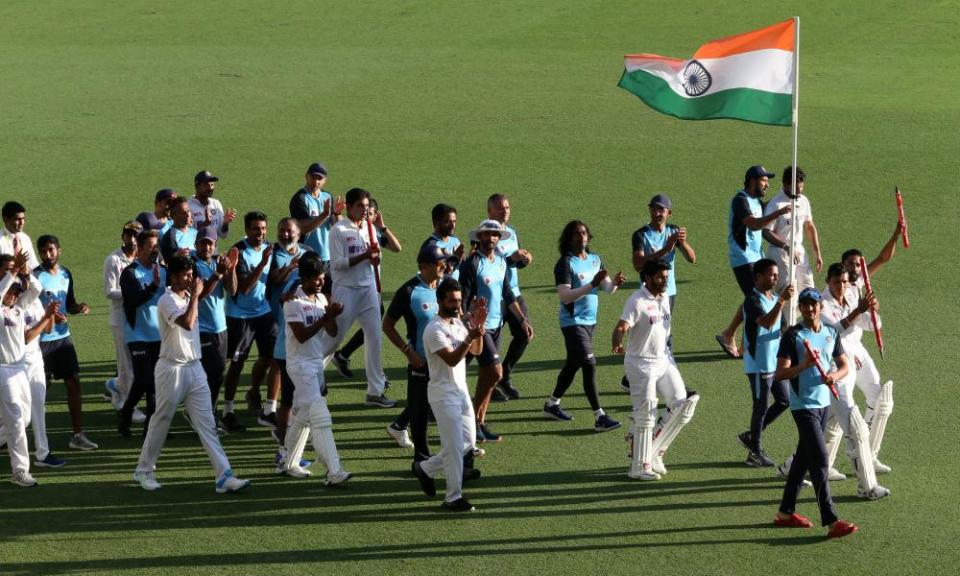Raw talent plus IPL cash point to an era of Indian dominance on cricket's world stage

The ground has moved after India’s win in Brisbane, lifted, shifted and settled again, so the game’s landscape looks a little different today. The premise of the World Test Championship seems a little redundant all of a sudden, because it’s addressing a question that has just been settled. New Zealand are still top of the official rankings, for now, and since they swept India aside 2-0 at home last February, they deserve the chance to try and beat them again in the final in England later this year. But whether they (or Australia, or England) qualify for that match or not, the future belongs to India, just as surely as the recent past did to Australia and, before them, West Indies.
Related: Tim Paine vows to soldier on as Australia captain despite defeat to India
In years ahead, this Test may look like a watershed, like India’s victory in the 1983 World Cup final, which sparked a boom in one-day cricket, and their victory in the first World T20 final, which led to the creation of the Indian Premier League. Take the long view, and the recent history of cricket is the story of India’s rise. Pretty much everything else is just a subplot.
It is not just that India beat Australia at the Gabba, where they hadn’t lost since the 1980s, or that they won the series after being bowled out for 36 in the opening game at Adelaide, but that they did it all when their captain was home on paternity leave, when one of their all-rounders and two of their best fast bowlers were absent while recovering from injuries, when another of their best batsmen was missing with a damaged wrist, a third and fourth had both injured their hamstrings, another of their fast bowlers broke an arm, another suffered a calf injury, another a side strain, their best spinner came down with back spasms, and his understudy broke his thumb.
Only two of the squad managed to play in all four Tests of the series, while a cast of 18 filled the spaces around them. The bowling attack they sent out for that final match was cobbled together from the net bowlers they brought on tour to keep their batsmen in trim. Two of the five, Thangarasu Natarajan and Washington Sundar, were making their debuts, the other three (Mohammed Siraj, Shardul Thakur, and Navdeep Saini) had played four Test matches and taken 11 wickets between them.
It was the most inexperienced Test match bowling unit they had put out since 1933. No one else in world cricket has anything like such strength in depth. Right now, India have enough about them that even at such a low ebb, they were good enough to beat Australia at their best.

After this, it is hard to imagine how they will start a series as underdogs again, wherever they play. It’s not just that, as Justin Langer said after the match, “there’s 1.5 billion Indians” to pick from. They have always had the numbers. But now they have the system to winnow and hone the best players from the largest talent pool on the planet.
In the last decade, for instance, India have developed a formidable ‘A’ team programme, led by the head coach Rahul Dravid. They’ve played 33 first class games in the last five years, which is more than twice as many as either Australia A or the England Lions have managed. And it is paying off. Siraj had taken 70 first-class wickets for India A in the last three years, Saini 34, Thakur, 23.
Related: 'Amazing' Rishabh Pant reminded me of Stokes at Headingley, admits Langer
And, driving it all, of course, is the IPL, the best, wealthiest, and most competitive cricket league in the world, with all the attendant resources of the eight competing teams. You may have missed this in all the excitement, but midway through the series the Indo-Asian News Service broke a story about the BCCI’s latest financial earnings, which date from 2018-19.
They were up by about 17% on the year before. Which means that right now, the board is worth around £1.5bn. Around a third of that is down to the IPL, which brings in more on its own than either the ECB or Cricket Australia’s entire annual turnover. And that was before the pandemic.
The BCCI is not going to be immune to the impact, but the IPL means it is a whole lot better protected than anyone else. The next two richest boards, the ECB and Cricket Australia, have both said they expect major shortfalls, the ECB has just cut 62 jobs due to an expected £200m deficit, and Cricket Australia has axed 40 jobs, and said it could lose around £70m.
The BCCI has made some cuts itself. And it is also embroiled in a few legal shemozzles that could have an impact, not least a tax wrangle with the Indian government.
But at the same time, according to the early reports, the 2020 edition of the IPL was the most lucrative yet. And it is only going to get bigger. Two more teams will be added from 2022, and the organisers will try to extend the season by a fortnight.
We spent a lot of the last decade talking about the “big three” of India, England and Australia. It feels increasingly like that’s going to become an outdated way of framing the game.
There is India, and then everyone else. In Australia one of the papers called this the Indian summer, it may just mark the start of the Indian century, too.

 Yahoo Sport
Yahoo Sport 





































